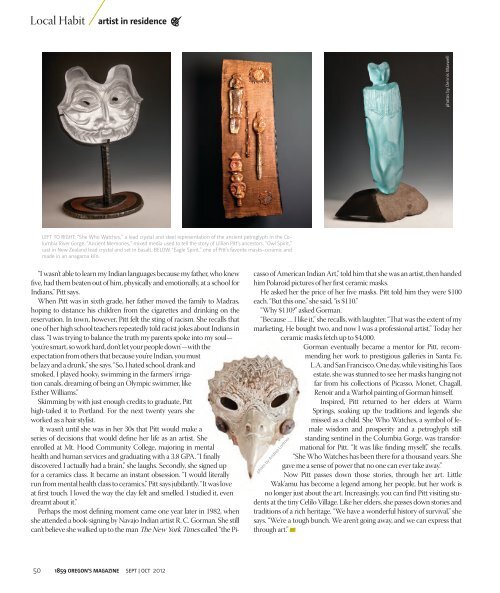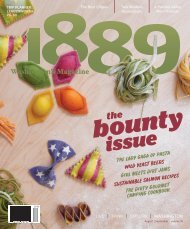Create successful ePaper yourself
Turn your PDF publications into a flip-book with our unique Google optimized e-Paper software.
Local Habit<br />
artist in residence<br />
<br />
RIG S <br />
R G P S<br />
N S P <br />
<br />
“I wasn’t able to learn my Indian languages because my father, who knew<br />
five, had them beaten out of him, physically and emotionally, at a school for<br />
Indians,” Pitt says.<br />
When Pitt was in sixth grade, her father moved the family to Madras,<br />
hoping to distance his children from the cigarettes and drinking on the<br />
reservation. In town, however, Pitt felt the sting of racism. She recalls that<br />
one of her high school teachers repeatedly told racist jokes about Indians in<br />
class. “I was trying to balance the truth my parents spoke into my soul—<br />
‘you’re smart, so work hard, don’t let your people down’—with the<br />
expectation from others that because you’re Indian, you must<br />
be lazy and a drunk,” she says. “So, I hated school, drank and<br />
smoked. I played hooky, swimming in the farmers’ irrigation<br />
canals, dreaming of being an Olympic swimmer, like<br />
Esther Williams.”<br />
Skimming by with just enough credits to graduate, Pitt<br />
high-tailed it to Portland. For the next twenty years she<br />
worked as a hair stylist.<br />
It wasn’t until she was in her 30s that Pitt would make a<br />
series of decisions that would define her life as an artist. She<br />
enrolled at Mt. Hood Community College, majoring in mental<br />
health and human services and graduating with a 3.8 GPA. “I finally<br />
discovered I actually had a brain,” she laughs. Secondly, she signed up<br />
for a ceramics class. It became an instant obsession. “I would literally<br />
run from mental health class to ceramics,” Pitt says jubilantly. “It was love<br />
at first touch. I loved the way the clay felt and smelled. I studied it, even<br />
dreamt about it.”<br />
Perhaps the most defining moment came one year later in 1982, when<br />
she attended a book-signing by Navajo Indian artist R. C. Gorman. She still<br />
can’t believe she walked up to the man The New York Times called “the Picasso<br />
of American Indian Art,” told him that she was an artist, then handed<br />
him Polaroid pictures of her first ceramic masks.<br />
He asked her the price of her five masks. Pitt told him they were $100<br />
each. “But this one,” she said, “is $110.”<br />
“Why $110?” asked Gorman.<br />
“Because … I like it,” she recalls, with laughter. “That was the extent of my<br />
marketing. He bought two, and now I was a professional artist.” Today her<br />
ceramic masks fetch up to $4,000.<br />
Gorman eventually became a mentor for Pitt, recommending<br />
her work to prestigious galleries in Santa Fe,<br />
L.A. and San Francisco. One day, while visiting his Taos<br />
estate, she was stunned to see her masks hanging not<br />
far from his collections of Picasso, Monet, Chagall,<br />
Renoir and a Warhol painting of Gorman himself.<br />
Inspired, Pitt returned to her elders at Warm<br />
Springs, soaking up the traditions and legends she<br />
missed as a child. She Who Watches, a symbol of female<br />
wisdom and prosperity and a petroglyph still<br />
standing sentinel in the Columbia Gorge, was transformational<br />
for Pitt. “It was like finding myself,” she recalls.<br />
“She Who Watches has been there for a thousand years. She<br />
gave me a sense of power that no one can ever take away.”<br />
Now Pitt passes down those stories, through her art. Little<br />
Wak’amu has become a legend among her people, but her work is<br />
no longer just about the art. Increasingly, you can find Pitt visiting students<br />
at the tiny Celilo Village. Like her elders, she passes down stories and<br />
traditions of a rich heritage. “We have a wonderful history of survival,” she<br />
says. “We’re a tough bunch. We aren’t going away, and we can express that<br />
through art.”<br />
0 <strong>1859</strong> oregon's mAgAzine SEPT OCT <strong>2012</strong>

















